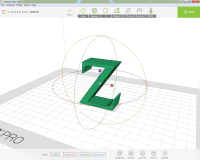Table of Contents
Introduction
Fusion 360 is a cloud-based, multiple environment, 3D CAD, CAM, and CAE (i.e. Computer assisted design, machining, and engineering) software tool. It is similar to other 3D software like Solidworks, CATIA, or Inventor. Not only is it easy to learn, but it also has a reasonably priced subscription model, and also has some attractive (i.e. free) licensing options for students, hobbyists, and enthusiasts.
This guide is a working document intended to provide:
- the basics of getting started with Fusion 360
- workflows and tips specific to using Fusion 360 with tools at VHS
- examples of the types of tasks you can accomplish with Fusion 360
- links to other tutorials and resources to facilitate further learning
Getting Started
Installation of Fusion 360 is straight forward, but does require you to register an account with Autodesk.
1. Navigate to http://www.autodesk.com/products/fusion-360 and download a free trial.
Once you have program installed and running, it is a good idea to make your way through Fusion 360 tutorials offered through Autodesk: http://help.autodesk.com/view/fusion360/ENU/ If you are already familiar with another CAD program, the videos are a quick and easy way to figure out what is similar and what is different.
Fusion 360 @ VHS
3D Printing
Once your design is complete, Fusion 360 can export a .stl file for 3D printing.
Coordinate System Tip
By default, the coordinate system in Fusion 360 uses a Y-up orientation, while most 3D printers use a Z-up orientation.
This means that when you import the stl model into your slicing software, the front face of your model will be oriented up.
To make designing for 3D printing more intuitive and to avoid having to rotate your part, you can change the default coordinate system of Fusion 360 to Z-up.
Click on your username in the upper right corner then click Preferences. Under the General tab, change dropdown Default modeling orientation to Z up.
Now, when you create a new model, the front view in Fusion 360 will correspond correctly to the front view in your 3D printer.
Laser Cutting
There are several different ways of generating the 2D profiles necessary for the laser cutter.
From a Sketch
You can export dxf files from any sketch by right-clicking on a completed sketch and selecting 'Save as DXF'.
It is a good idea to separate sketches used for design intent with those to be used as cut profiles. When a sketch is saved as a dxf, all of the lines, including and construction lines or duplicate lines, are exported. This can cause problems in the laser cutting software or make it necessary to clean up the file using an intermediate program.
DXF Export Tip
To export a “clean” dxf, create a new sketch on the face you want to cut, then exit the sketch. The sketch will only include the geometry. It can be helpful to rename the sketch as a reminder and then save as a dxf as above.
From 3D Geometry
Slicer for Fusion 360 is a great tool for making your 3D models from 2D material. It is a free add-on and is based on the no-longer supported Autodesk 123D Make. Using this tool, you can select from a variety of different construction techniques to generate 2D cut paths.
CNC Machining
<In Progress>
Example Projects
<In Progress>
Learning Resources
https://www.youtube.com/watch?v=7riGolu7BpA
- This video outlines how to model a laptop stand to be cut with a laser cutter. It does a good job of explaining how to use parameters to make easily adaptable and customizable designs. It also does a good job of showing how to use Boolean operations between bodies to make slots and joints. Finally, the method for generating cut paths by creating sketches on existing faces works extremely well.
http://www.learningfusion360.com/lesson-6-modelling-a-chess-pawn/
- This site has several good tutorials. This particular one outlines how to import an image as an attached canvas and use it to create a properly scaled model of a real life object.











